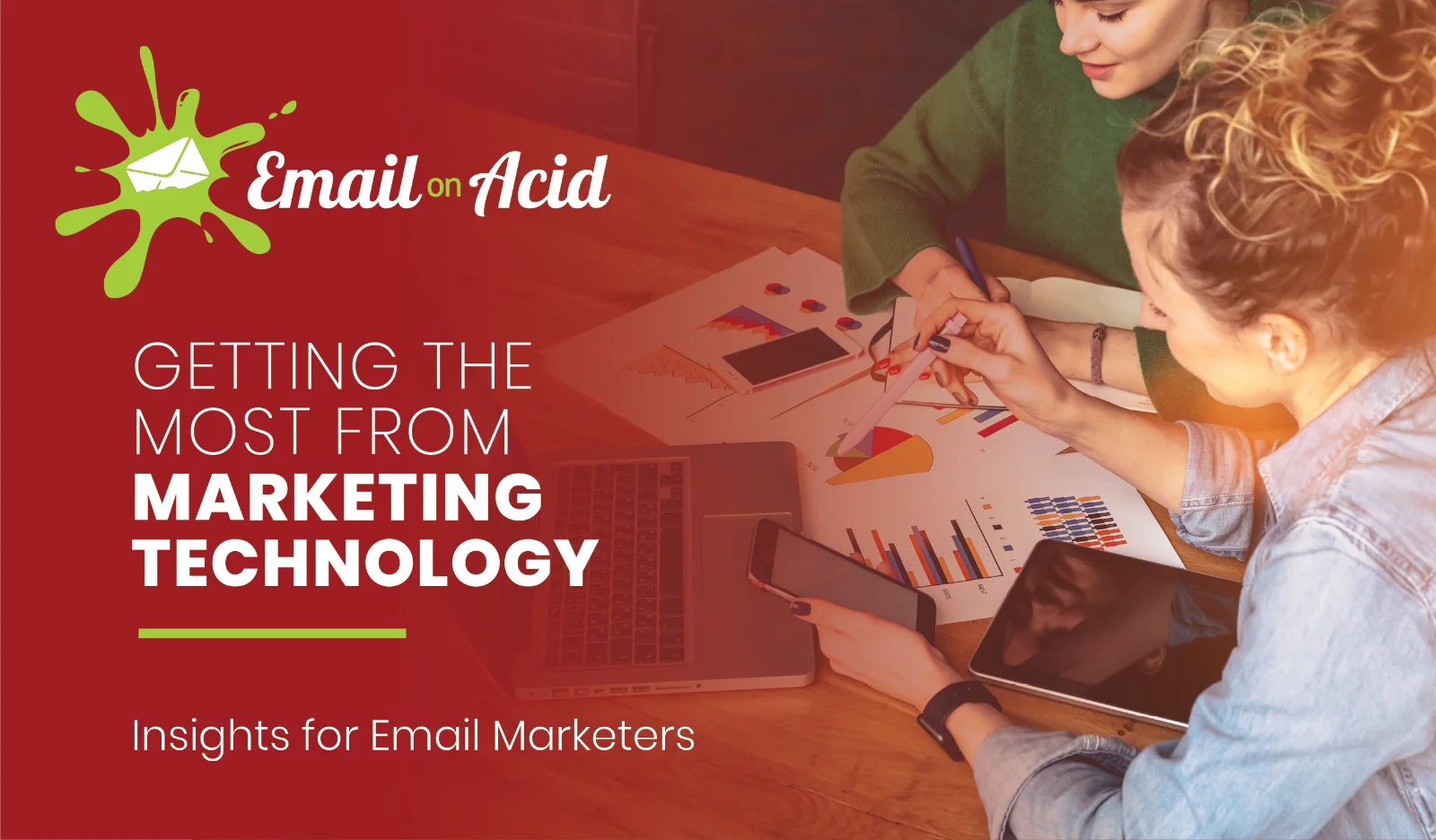Email Marketing
B2C Email Automation: 10 Campaign Ideas for Consumers
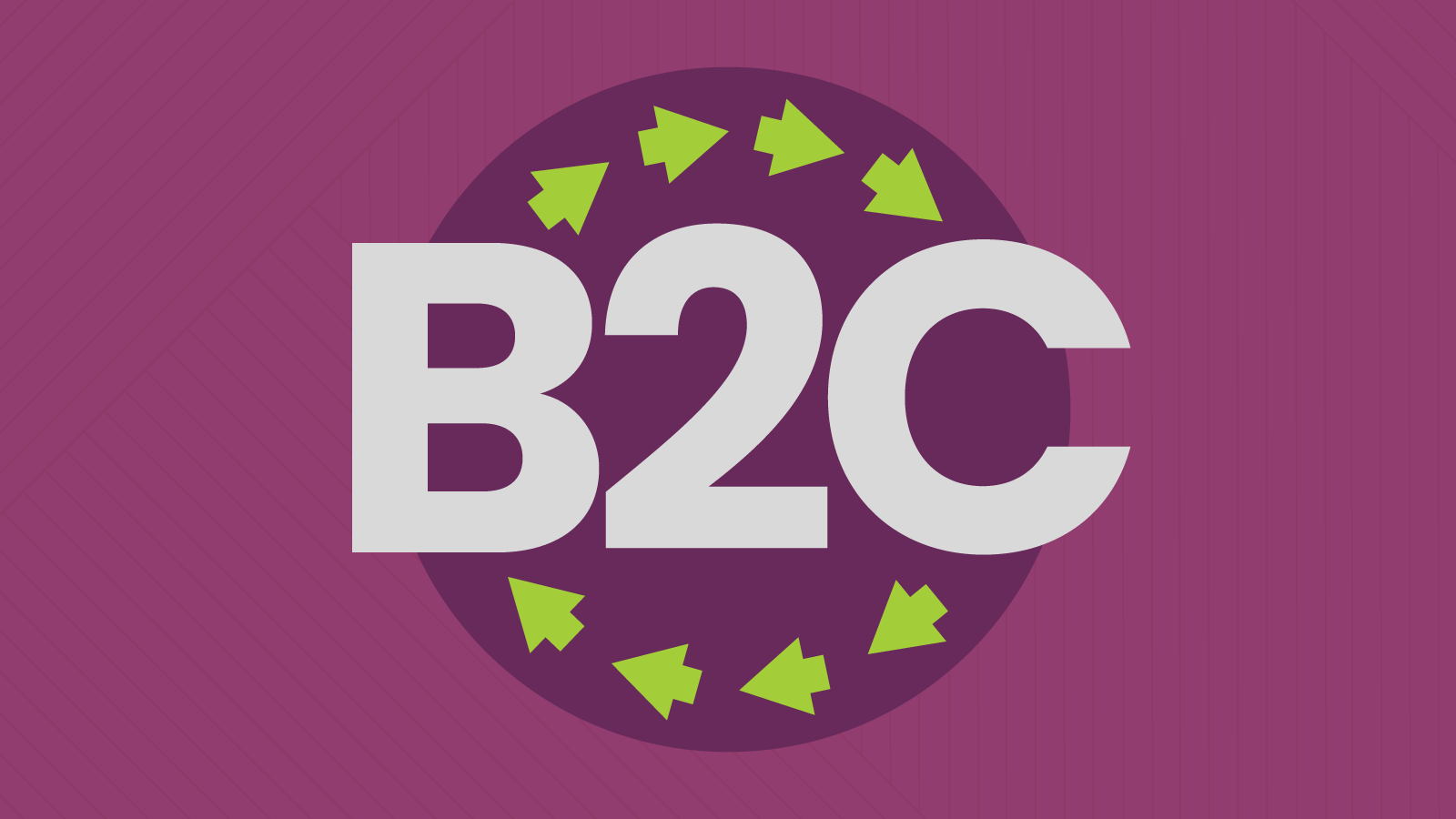
Email Marketing

It’s advice that email marketers hear over and over again: To be successful, you need to deliver the right message to the right person at the right time. The only way to accomplish that at scale is to set up automated email campaigns.
B2C email automation can get complex. But with a solid strategy and the right marketing automation platforms, you can implement automated emails that keep consumers engaged with your company, enhance their experience, and turn browsers into buyers.
Our report, Getting the Most from Marketing Technology, revealed improving the customer journey to be one of the three most-cited goals of best-in-class marketers. In an industry survey, improving the customer journey followed only the goals of improving marketing efficiency and improving data quality.
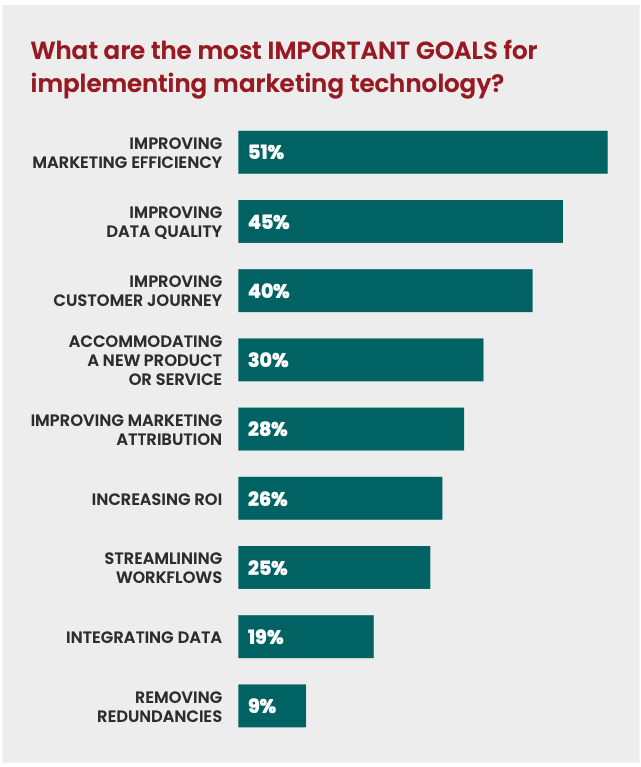
The truth is, well-planned B2C email automation can help you achieve all three of these goals.
But first things first. What types of automated email marketing campaigns should your B2C brand implement? Here’s our list of the most important and effective email series for consumers.
A commonly used B2C email automation for eCommerce, abandoned cart messages are delivered when subscribers add items to their carts but don’t complete a purchase. Cart abandonment is common. Super common. Numbers vary but hover around 70%. An automated recovery program will certainly reduce this number.
You might send an email a few hours after abandonment that shows the item the shopper was interested in and asks if they still want to go through with a purchase. The hope is that this simple reminder will bring back a distracted consumer.
This is fine, but you can take things much further. You might use the opportunity to overcome common objections or offset the advances of a competitor. Remind your potential customer of your key value proposition, or build trust by including a prominent endorsement or recent review.
But remember, this is a customer journey. You aren’t limited to a single abandoned cart email. You can’t expect to convince every reader with just one email. But a series that builds your case and ends with a discount only after you’ve exhausted your other options, might be most effective.
Try to understand common objections that explain why consumers leave items in their cart. Is it the product’s price or the cost of shipping? Maybe it’s a complicated checkout process, security concerns, or forcing account creation. Working with those who own the customer or user experience (CX and UX) helps inform your abandoned cart email strategy.
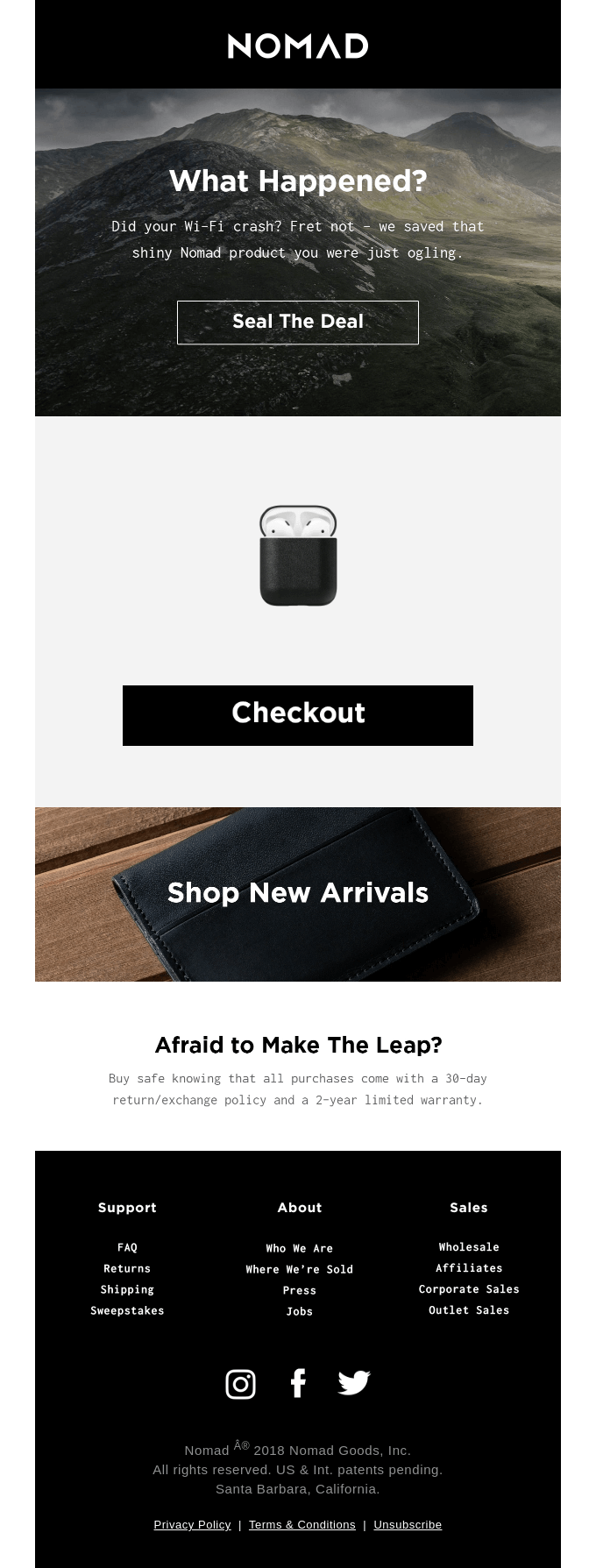
This abandoned cart email from Nomad is a great example of a first point of contact. There’s no discount offer; it’s just a fun way to ask if the customer wants to continue. Near the end, however, they help overcome consumer hesitations by reminding the subscriber of their generous return policy.
If you sell something that consumers often finance, you can provide a way for them to learn more by browsing financing options. The further subscribers advance into their journey, the more likely they are to become customers.
To turn new customers and subscribers into brand advocates, you have to first deliver a great experience.
A new customer welcome email series helps keep their excitement level high, which is particularly important if you offer a free trial or limited cancellation window, or if your product requires a time commitment to see results, like a fitness app.
It’s also a great opportunity to build brand affinity as well as inform them of other products you offer. Share examples of other customers having success or enjoying your products. Tell the story of how proceeds from their purchase are being used to promote positive change in communities around the world. Provide insight into your company’s culture and give subscribers more ways to get involved.

This friendly email from Warby Parker does everything right. It offers new subscribers several options for engaging with the brand, and provides information about the company’s “buy a pair, give a pair” initiative.
You don’t want to wait to connect with new customers until the next scheduled marketing campaign rolls around. You want to reach out to them immediately, especially if your email opt-in is incentivized. With a new customer welcome series, you can reach out to the people who are most eager to hear from you!
A transactional email provides basic information to subscribers about a purchase they’ve made or an order they’ve placed.
Customers use these emails for peace of mind about their order status, to track their purchase, receive a digital product, or confirm a cancellation. They’re often your first steps towards building long-term trust and earning a customer for life.
Since customers are highly likely to open this type of B2C email automation, smart marketers use them to stand out with custom content and added value.
So beyond tracking information or a notification that a package is “on its way,” consider providing a section for, “while you wait.” Or tease a special bonus you’ve inserted into their order. If it’s something that takes a few days to prepare, such as a customized item, give them a behind-the-scenes peek at the process.

Frontier’s flight itinerary confirmation is a masterclass in transactional emails. It clearly identifies the contents and immediately gives critical information in an easy-to-consume manner. Then, it provides a checklist to guide passengers through their next steps. Notice that the first box is already pre-selected with a line that provides reassurance and builds brand identity: “I bought my tickets with Frontier and got the best flight deal!”
You may want to sprinkle some upsells and other promotions into transactional emails, but tread carefully with that approach and be respectful. Consumers aren’t required to opt-in to these automated emails. So make sure information is the main focus. A good rule of thumb is that no more than 25% to 30% of a transactional email should be marketing-related.
You don’t want consumers marking these emails as spam, either. Besides sticking to transactional info, be sure they match your brand’s style, especially if the emails come from a third-party service.
Some B2C products don’t lend themselves to immediate purchases. New technologies, complicated products, or high-value items with long sales cycles might require your company to educate subscribers before they make a commitment.
Instead of overwhelming consumers with a long, 20-point fact sheet, consider dripping out this information in a series. Focus on the most awe-inspiring benefits first and then move towards overcoming objections and building trust through stories, examples, reviews, and more.
But what about after a customer has made their first purchase?
If someone has difficulty using their purchase, everything else you do falls flat. By providing new subscribers or customers with educational email content, you can help them use your product successfully and increase the chances they remain subscribed and make future purchases. Plus, educational content solidifies your company’s expertise. As your voice and advice become more trusted, your sales offers will have a greater impact.
But don’t just drip out generic instructions from your training manual — that’s not very interesting. Increase your engagement and form a faster connection with new customers by using the real name and face of a support team member in your welcome emails. Encourage the reader to reply with questions, or direct them to the proper avenue to get in touch. It feels less like they’re just another number and demonstrates your company’s commitment to their success.
You can also deliver educational content through B2C email automation to inform customers about how else you can help them or what other products you offer. Some may come to you for a specific reason, but then go to a competitor for other solutions you already offer.
Sonima Wellness offers wellness-related solutions beyond yoga. But not everyone who subscribed because of yoga tutorials may know about their guided meditations, fitness classes, and food-related services. The email below incorporates helpful content about their other services. It’s not a sales email — it provides useful information to people who’ve already indicated their interest in wellness. But it also adds credibility to the brand while educating subscribers about additional product lines.
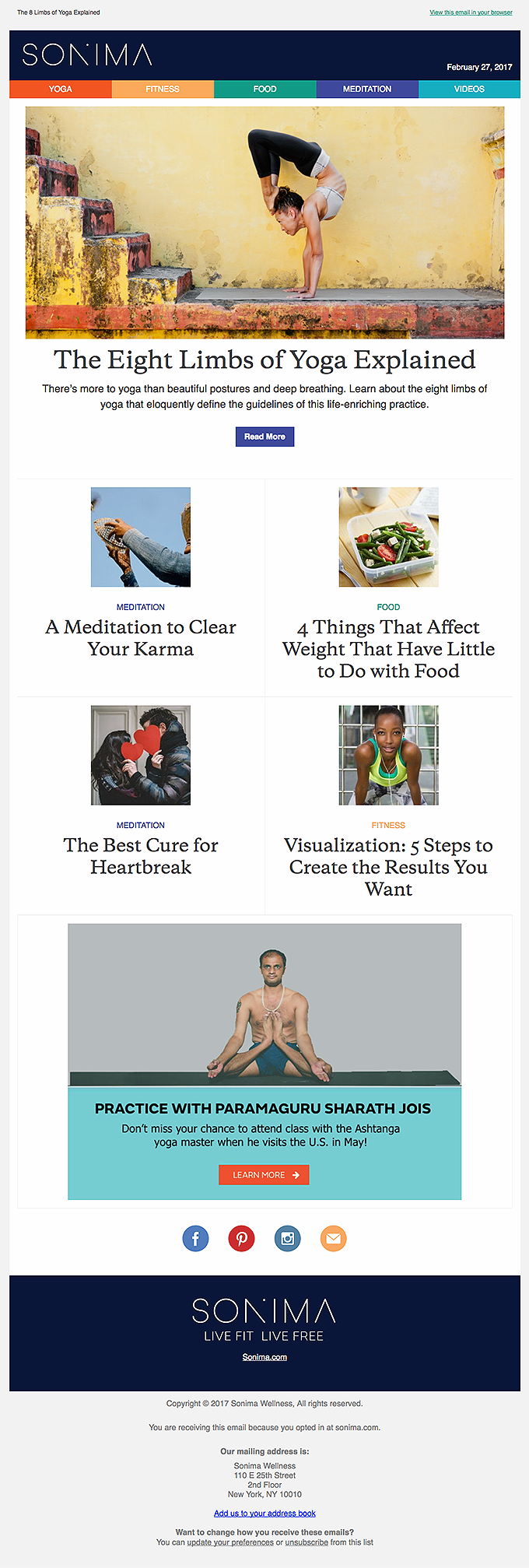
If you’ve delivered a stellar experience, you want that vote of confidence from a satisfied customer. You want them to shout it from the rooftops! And if the customer had a not-so-great time, don’t you also want to know so that they don’t shout it from the rooftops?
An automated customer satisfaction series can accomplish both of these tasks and more.
It’s an opportunity to ask for a great review at the height of your new customers’ excitement. According to TrustPilot, 89% of consumers seek reviews before purchases. So, these kinds of campaigns are well worth the effort.
Test to see what timeline works best for your company, but most companies send these within a few days of order delivery.
Consider using a bit of psychology by encouraging customers to leave a review if they enjoyed their purchase. Chewy takes this a bit further but subtly suggesting five stars through the graphic at the top.
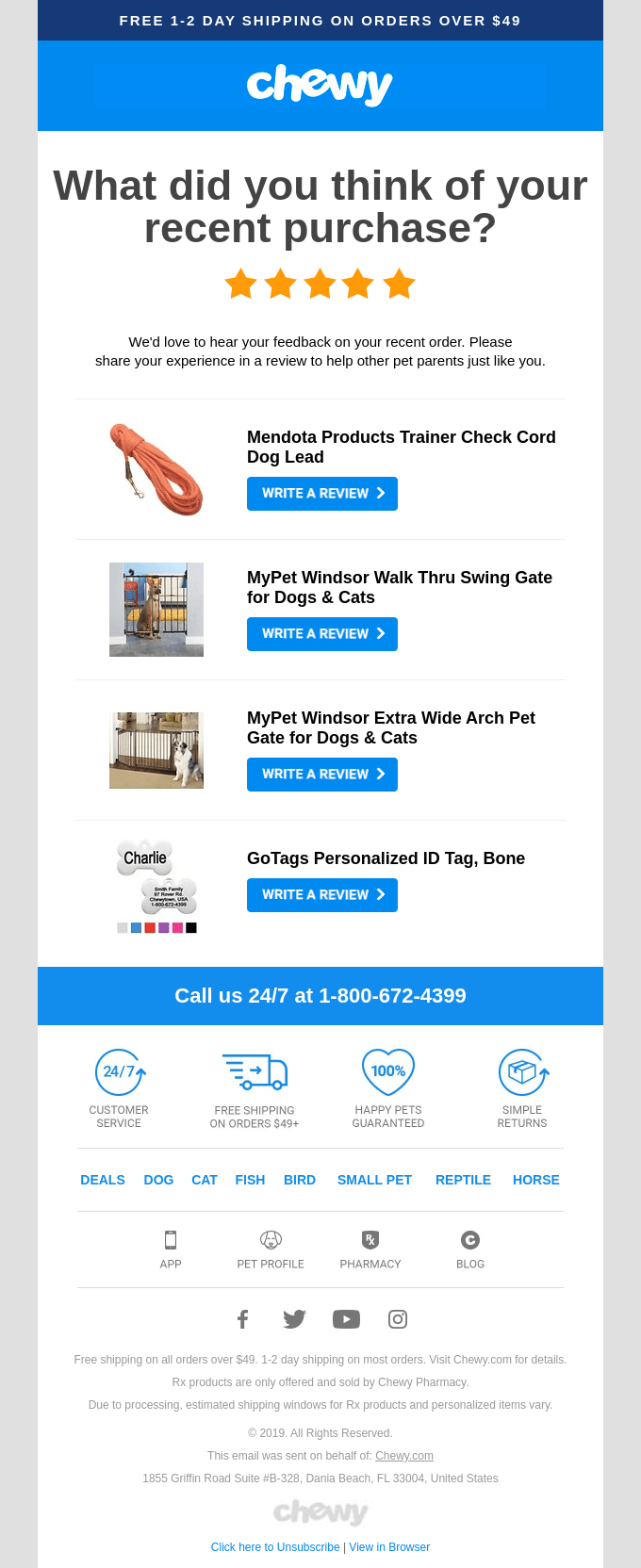
You can also provide an opportunity to make things right. If someone did have a negative experience, you might be able to prevent a bad review.
Enjoy your product?
Great! Please leave a (five-star) review.
Not so much?
We’ll make it right.
Target does this well.

Follow-up emails are about more than reviews. They can also help you keep tabs on your operations and catch small problems before they become big ones. Send a survey with a short series of questions about key areas. You may identify ways to improve, but you can also monitor your average rating. If your packaging normally gets 9 out of 10, but suddenly drops to a 5 out of 10, it’s time to investigate!
Everyone likes to feel special! Show appreciation for subscribers with a note on their birthday or a gift on the anniversary of their first purchase.
This tactic has become quite popular, however. So now the challenge is to stand out. One way is to focus beyond the big day itself.
Are you familiar with the “Twelve Days of Christmas?” How about a “five days of birthday?” This series might start on a recipient’s birthday and last several days after other companies’ celebrations have passed.
Hulu’s birthday email is brilliant because it successfully uses several strategies at once.
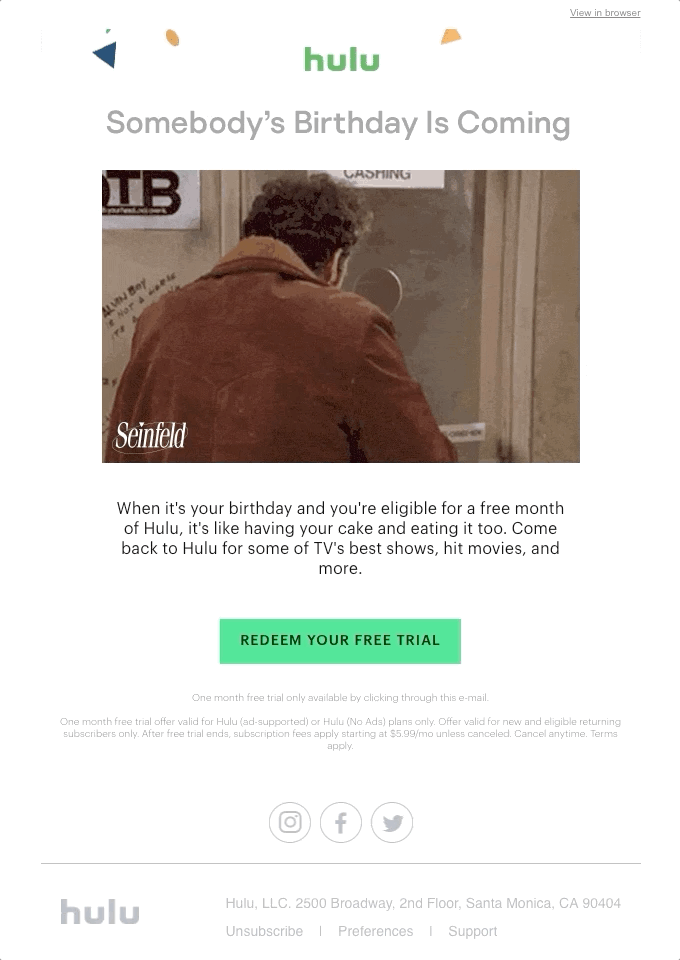
A B2C email automation that re-engages customers is a powerful opportunity for marketers because the audience is already familiar with their brand. Invesp found that it costs much more to win a new customer than to sell to a previous one. So even though it might have been a while, don’t ignore your dormant subscribers!
Before you launch this type of B2C email automation, it’s smart to cleanse your list. Sending to bad email addresses or contacts who haven’t engaged in more than a year could negatively impact your deliverability. Discover some list cleaning best practices to get started.
To win back customers, a special offer is nice. But it doesn’t address other common reasons your previous customers have disengaged. Maybe you lost their trust or they were swayed by a competitor. Or their needs, life circumstances, or tastes may be different than when they originally found you. They might have no idea that you offer other products.
Suppose you sell novelty t-shirts based on various television series. A customer once regularly purchased shirts related to a particular show. But over time, their interest faded and they haven’t made a new purchase in nearly a year. Sending the same promotional emails featuring the original show won’t work anymore; their interests have changed.
It’s time to engage them with something new. Did they know you also carry shirts about other programs? Maybe one of those just happens to be their new obsession!
Or maybe their life place has changed. They’re buying fewer clothes for themselves and more for their new baby. Did they know you also offer clothes for little ones?
This win-back email from Clear doesn’t just offer a discount. That’s not even the primary message. Instead, it focuses on the improvements that have been made to the service. It’s likely that they received feedback from former customers that the speed of service wasn’t worth the price they paid.
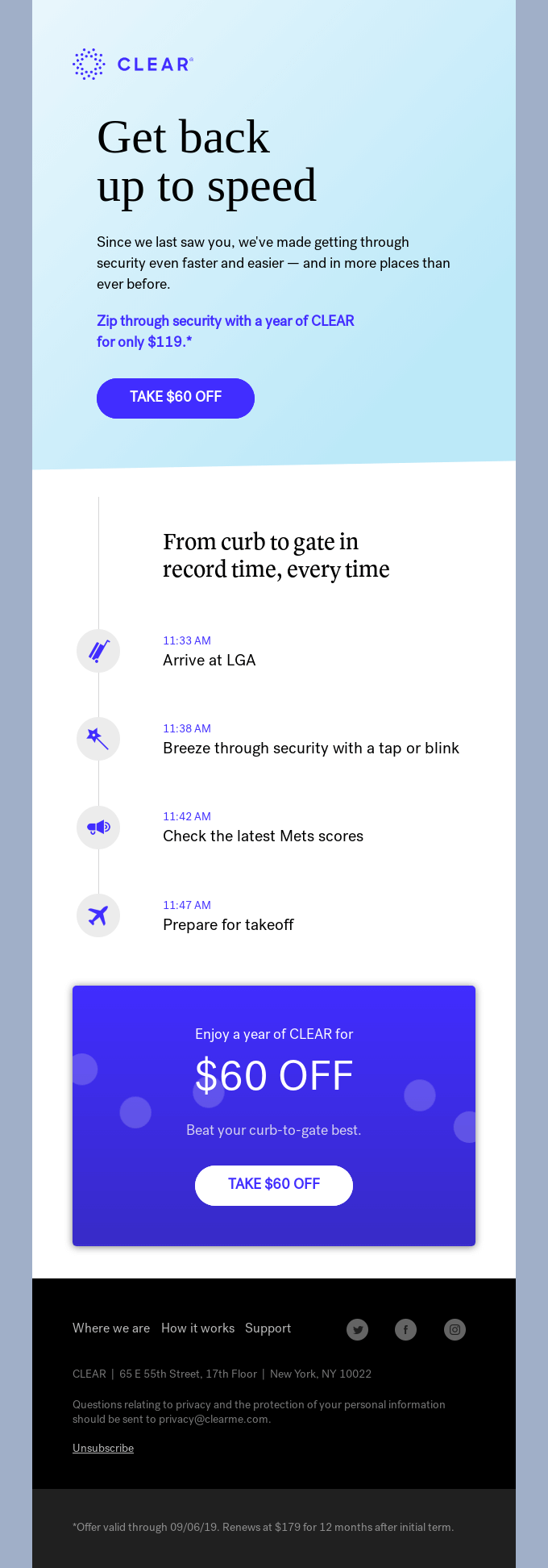
They’ve addressed both and done so in a simple, visually appealing way.
You’re ready to launch your new product. Exciting! Don’t forget to tell your existing or previous customers — they’re likely some of your best prospects!
If new product launches or upgraded releases are a regular thing at your company, you can announce each one, even throughout a multi-part email series, without fatiguing your subscribers with too much volume. How?
The most obvious way is to only send to segmented portions of your list based on previous order history. If someone’s only ever purchased vegan options from your shop, you might not need to notify them every time you release a new beef jerky flavor.
But sometimes you do want to let everyone know about a category expansion or other new release. After all, many subscribers may not be aware of the extent of your offerings.
You can send a multi-part, automated announcement series while still minimizing the risk of fatigue. Just make the nature of the release clear in the subject line. Then, before you send the third or fourth email in a series, filter out subscribers who received the first two emails but didn’t open them. Though not a perfect science, if they didn’t open the first two, they may not care to see you try and try again. Meanwhile, folks who did open them are likely still interested in learning more.
Google used this style of email to announce the launch of their Pixel 4a smartphone. It featured compelling images, listed the top benefits and features, and included a clear call to action to pre-order now.

These are just what they sound like: automated messages that send when a subscriber takes a specific action. Abandon a cart, purchase a product, or join your list — these are all activity-based triggers that can start a series. If you’re thinking this sounds similar to some of the ideas we’ve already discussed, you’re right.
You can further customize most automations based on many different triggers. If someone clicks through an email in an education series to learn more about financing, this could trigger the start of a new series about financing basics.
Consumers respond to relevant messages with perfect timing. Activity-based triggers don’t have to be annoying. Sometimes, they save the day and make you the hero.
If a former customer returns after a long time away, send an automated email that offers a one-on-one consultation. If someone reads a certain blog post, send more information around the subject of the post. This is “next level” email marketing for teams that have an in-depth understanding of their target audiences and the customer journey.
Maximize your average customer lifetime value using B2C email automation to make sure they order again and again! Many products have a limited shelf life or finite usage. If your makeup product lasts the typical user around 30 days, you might consider reminding them to re-order after 21 days. Encourage them to “never run out!” You can automate these kinds of emails so your sales team works day and night.
Apple Music keeps their email simple, with an eye-catching image, a compelling reminder to turn on automatic renewal, and a colorful button that takes customers straight to the renewal landing page.
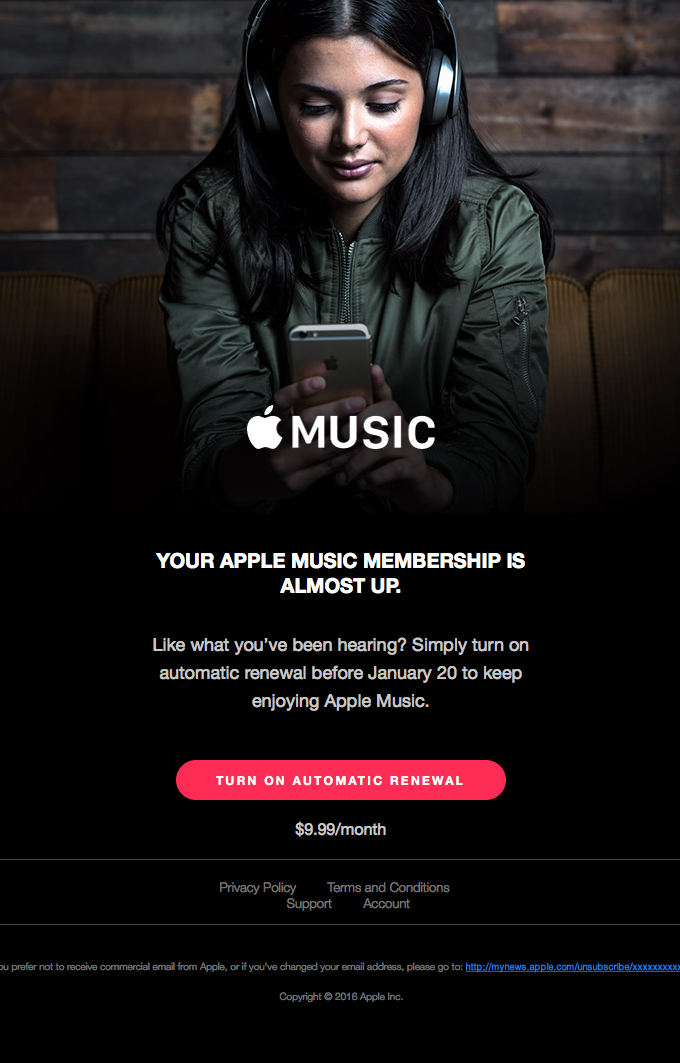
If your customers don’t renew or reorder after a few attempts, you can always try an incentive like a discount or bonus item. Use this opportunity to suggest alternative products or services that customers with similar traits often choose.
When you’ve got your automated email programs dialed in, it becomes a finely tuned machine that seems like a marketer’s dream. But to get the best results, you’ll always need to measure data and tweak your sequencing, messaging, visuals, and more.
As a result of these tweaks, or because email is always evolving, sometimes a B2C email automation breaks. That’s why regularly running your automated campaigns through an email testing platform like Email on Acid is a must. Without periodic testing of each template, your results could slip dramatically before you discover the problem.
Email on Acid makes sure your emails are ready for maximum effectiveness. That’s why we call it an email readiness platform. It ensures that your links are correct, language is spot-on, images show up properly, and messages will bypass spam filters and go straight to the inbox. And, like the best marketing automation tools out there, it streamlines your processes so that you can launch automations faster and with perfect accuracy.
Ready to hit the send button with confidence? Check out our plans and pricing to learn more about Email on Acid.
Before you can automate your emails, you need the right tools to make it happen. Find out how best-in-class marketers research, evaluated, and implement marketing technology.
Get our free report to find out more and discover insights for email marketing teams.
